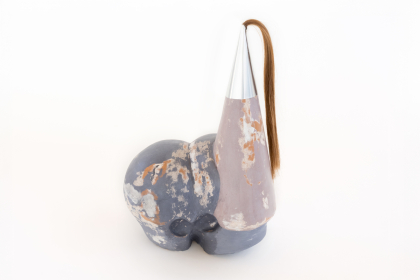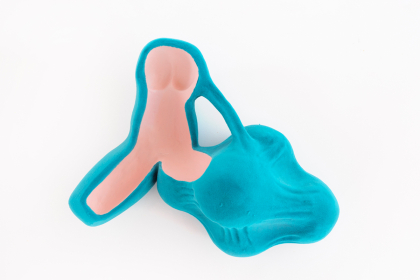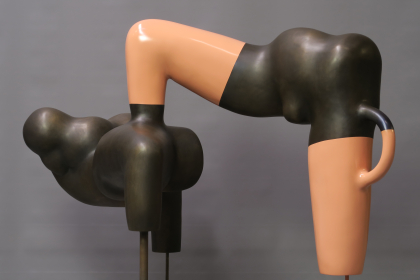Anton Cotteleer (°1974, Antwerp)
Lives & works in Kalmthout (BE)
Video: Jan Weynants
Cotteleer is mainly known for the combination of modelled human and animal fragments with deconstructed domestic objects. He is interested in the relationship of humans and animals to the domestic biotope, which is seen as authentic and personal within the Western world, yet mostly interchangeable and conducted.
Ambiguities and dualities keep the work in a grey zone. Eroticism, innocence, mysticism and banality each claim their presence but are always negated by each other. Visual and substantive contradictions set the tone. As a result, the works are rarely explicit and remain partially elusive. The works contain autobiographical traces in addition to memories from collective memory. Memories, whether fed by personal photographic material or not, are used. However, this is not applied consistently, putting the artist and the viewer in an uncomfortable position. Questions around the authenticity of memory, truth and illusion intrude.
Anton Cotteleer, August 2022
Anton Cotteleer
“Memory can change the shape of a room; it can change the color of a car. And memories can be distorted.” (Memento, 2000)
Sometimes, our memories are blurred. You think you remember something; you can picture it very clearly. Until someone comes up with another story that sounds just as credible. Was it like that after all? Did my imagination indeed play tricks on my memory?
Anton Cotteleer is working on a doctorate in the arts. Working from personal and anonymous family photos from the 1970s and 80s, he investigates how haziness - or, to put it more visually, blur - determines our perception of an image and how he might translate this into sculpture, his main discipline.
Photography enjoys a specific status in the appreciation of art. Indeed, viewers tend to think that a picture tells the truth - that it represents a true fact. In the case of Cotteleer's photo albums, this is also largely the case: the images are mostly innocent, personal memories; birthday parties or day trips that he and his loved ones look back on with pleasure. However, as he manipulates the photographs, that innocent, banal factuality disappears. By magnifying the analogue images, he selects fragments, secrets from the darkest corners of the image or actions that, once isolated, take on a more mysterious character.
“When scrutinising the scanned copies, I discover new elements, colours, suggestions and reflections. Since we are dealing with analogue images taken by amateurs, zooming in almost automatically generates an overall ‘blurriness’.” (Anton Cotteleer, An Out-of-Focus Scan, Part 1, 2021)
Due to the blurred nature of the zoomed-in fragment, the object of the photograph is barely recognisable. This creates new forms, new interpretations which Cotteleer subsequently appropriates. In the same way that our memory can sometimes present us with the most irrelevant details, or preserve the vaguest trace of a memory, the artist allows his imagination to interact with the manipulation of a personal and all too familiar snapshot.
In the first publication issued in connection with his doctoral research, An Out-of-Focus Scan Part I, Cotteleer shows how, by zooming in, cropping and enlarging, he manipulates the photos and infuses them with a new narrative potential. These are the first steps towards the creation of the sculptures that he ultimately wants to achieve. Every stage of the thinking and working process, from the enlarged photos, through the process of sketching, to reliefs in silicone and textile, and finally the realisation of the sculpture, constitutes a new manipulation and reinterpretation of the image. With every anecdote that is told, memories change; with every scan, different aspects of an image come to the fore. Every new intervention on the supposedly factual representation of a moment both questions the veracity of the medium and seeks to create a new artistic narrative.
“Blurredness stimulates the critical distance to familiar phenomena. Only when the blurred photograph becomes too abstract to stimulate the imagination of the observer, the process of active perception is broken off.” (Hilde Van Gelder en Helen Westgeest, Photography Theory in Historical Perspective, 2011)
How does the blurredness - the lack of sharpness - in Cotteleer's photographs translate into sculpture? In earlier sculptures, he used a ''soft skin''. The contours of the sculpture become softer, less sharply delineated, and therefore, in a certain sense, more human. It is precisely this that constitutes the basis of his interest in the blurred, the out-of-focus. Currently, he is also exploring the possibilities of (this) skin in photography and reliefs.
The reliefs that Cotteleer created in the frame of this research form a link between the photographs and the sculptures. The pictures - which, incidentally, can also create their own kind of skin over the years, in the form of mould or other biological or chemical reactions on the paper - usually have a smooth surface, while the reliefs can be made to have just enough texture to produce a seductive tactility.
The process of zooming in on body parts and skin quickly takes on a soft, sensual quality in the photographic images. The artist continues this in the reliefs and undoubtedly also in the sculptures, where fragments of bodies find each other. In a surreal, almost hallucinatory manner, he brings together body parts and objects, which fuse together in a sculptural manner. The question where this path leads to forms the impetus of the exhibition, and the continuation of his research.
Cotteleer recently started working in bronze, after discovering the material’s surprising properties during a workshop in China. There is also a great deal of sensuality in his bronzes: although there are no recognizable limbs, a certain formal, physical movement is enhanced by the shine and reflection of the material. Where in his other sculptures there is some innocence, due to the matte layer of fibers or the lighter colours, in the bronze he explores a more serious and charged plasticity.
Tamara Beheydt, October 2021.










































